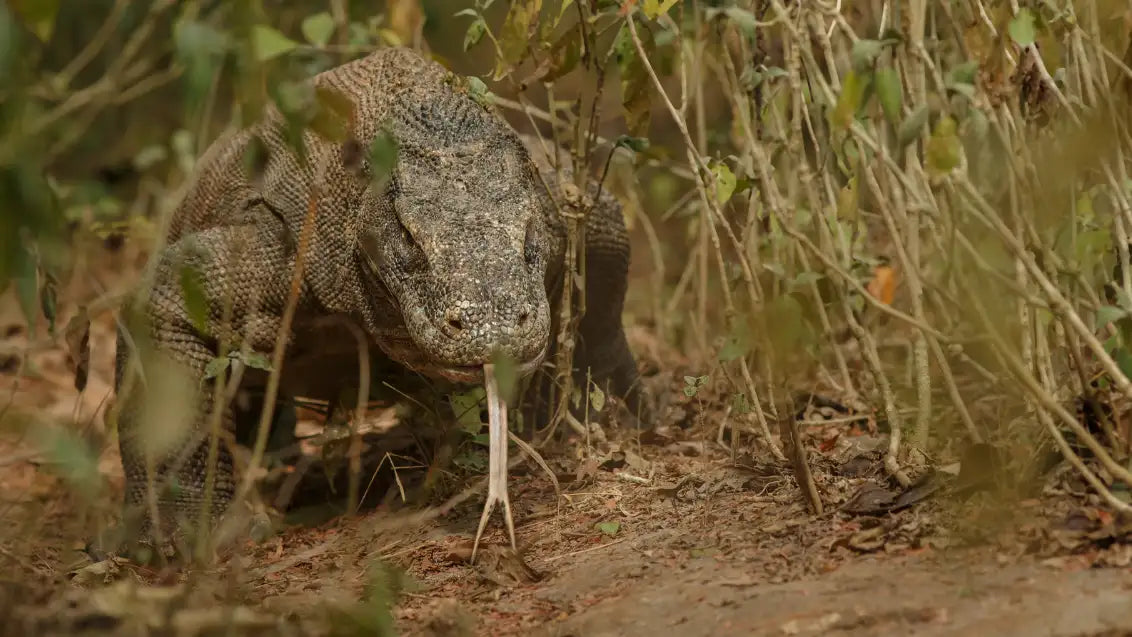
Komodo Dragon: Can you have a komodo dragon as a pet?
We bet, you must have seen those cute baby komodo dragon video on you IG reel, right?
The Komodo dragon captures the imagination with its size, strength and ancient lineage. They are native to Indonesian islands. They have intrigued scientists and animal enthusiasts for decades. But can you have a komodo dragon as a pet? This idea raises numerous questions and concerns. Before getting the answer, we should have understood about how they live, their behavior, what they eat and the feasibility of keeping them as pets. We are here to tell you everything you should know about the Komodo dragon.
What is a Komodo Dragon?

Komodo Dragon has the scientific name Varanus komodoensis. Komodo dragon is the largest species of lizard. It can grow up to 10 feet in length and weigh as much as 150 pounds. These reptiles are known for their powerful build, sharp claws and serrated teeth.
| Habitat | Indonesian islands |
| Diet | Carnivorous (Komodo, Rinca and Flores) |
| Lifespan | 30 years in the wild |
| Conservation Status | Vulnerable |
| Types of dragon lizards | Features |
| Bearded dragon | Tan, brown, popular pet lizard and calm |
| Komodo dragon | Grey or brown, largest lizard, venomous |
| Red dragon lizard | Red, rare species and vibrant |
| Flying dragon | Gren or brown, semi-aquatic and known for climbing |
Natural habitat and behavior

We will now see the habitats and behavior of komodo dragons.
- Habitat: Komodo dragons are found in the hot and dry savanna landscape of Indonesia. They prefer open grasslands and forested areas where they can bask in the sun and find prey. They live in temperatures from 95 F to 110 F.
- Behavior: Komodo dragons are solitary creatures that come together only to mate and feed.
| Behavior | Description |
| Hunting | Ambush predators, rely on stealth and power |
| Social structure | Solitary, except during mating and feeding |
| Reproduction | Lay eggs with an incubation period of 8 months |
How many self-defense weapons can a komodo dragon have?
Komodo dragons possess multiple self-defense mechanisms, making them nearly invincible in the wild. Their top self-defense weapons include:
- Powerful Bite: Inflicts deep wounds with venom.
- Sharp Claws: Used for slashing enemies.
- Thick, Armored Scales: Protect against attacks.
- Whipping Tail: Can knock down prey or rivals.
- Speed: They can sprint up to 12 mph.
- Camouflage: Blends into the surroundings for stealth.
- Aggressive Nature: Deterrence through intimidation.
Diet and feeding habits of komodo dragons

Komodo dragons are known for their voracious appetite. They can consume up to 80% of their body weight in a single meal. Their saliva contains toxic bacteria and venom. Their saliva's bacteria and venom can cause severe infection and shock. Komodo dragons digest bones using powerful stomach acids. Their diet usually includes deer, pigs, water buffalo, smaller dragons and carrion.
Komodo Dragon jaw muscle: Komodo dragons have extraordinarily strong jaw muscles that allow them to bite with immense force. Unlike other reptiles, their jaw structure enables them to hold onto struggling prey while their serrated teeth slice through flesh effortlessly. These powerful muscles, combined with venom glands, make their bite deadly, ensuring that even large prey cannot escape.You may see the labeled komodo dragon anotomy for better understanding.
Can you have a komodo dragon as a pet?

Before going into the question of ‘can you get a komodo dragon as a pet’?, we should see the following considerations:.
| Considerations | Desciptions |
| Legal status | Endangered species, ownership restricted |
| Ethical concerns | Space, care, diet, and danger to humans |
| Permitted required | Special permits needed for ownership |
Challenges:
Here are some challenges to a komodo dragon as a pet:
- Space requirements: Komodo dragons are large animals that need sufficient space to roam and show natural behavior. A typical household would be insufficient to meet their needs. In captivity, Komodo dragons require enclosures that mimic their natural habitat.
- Dietary needs: It is difficult to provide a proper diet for a komodo dragon. They require large quantities of fresh meat, which is difficult and expensive to source. Also, their feeding habits and the need for live prey or freshly killed animals are an ethical and logistical challenge.
- Safety concern: Komodo dragons have sharp claws, strong jaws and venomous saliva that can cause severe harm to humans. Caring for them requires training and knowledge, which makes it unsuitable for the average pet owner.
- Veterniary care: It can be tough to find veterinary care for a komodo dragon. They have unique health needs and require specialized medical care that other vet practices cannot practice.
What are the alternatives?

- Since you might have the answer to: ’Can you get a komodo dragon as a pet?’ we can also look for the alternatives for komodo dragons as pets.
- Visiting zoos and sanctuaries: You can visit zoos and wildlife sanctuaries. Zoos provide a safe and controlled environment where you can observe them up close. It is a good alternative to komodo dragon as a pet.
- Supporting conservation efforts: This is a good way to support komodo dragon by contributing to conservation efforts. Donations, volunterring and spreading awareness can make a significant impact on their protection.
- Keeping smaller reptiles as pets: This is a good alternative to keeping komodo dragons as pets. There are smaller species that can be kept responsibly. Bearded dragons, leopard geckos and ball pythons are popular choices.
FAQs
You must be excited seeing a huge komodo dragon walk slow motion on your YT or IG feed!!. While the idea of keeping komodo dragon for pet may be tempting but there are legal, ethical and practical challenges that make it unfeasible and potentially dangerous.
Instead, we can enjoy the magnificent reptiles by supporting conservation efforts. You can also visit zoos and sanctuaries. By understanding the needs and their behavior, we can conserve and continue to marvel at them.
You can also check out PetsbyNumber for paint by number kits for awesome customized komodo dragon pictures.

